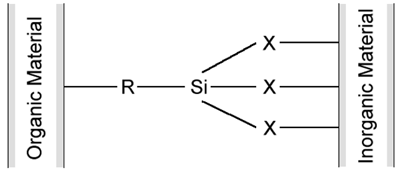|
|
| Silane coupling agents are generally illustrated: |

Silicone (Si) is
the center of the silane molecule which contains an organic functional
group (R) [ex: vinyl, amino, chloro, epoxy, mercapto, etc.], with
a second functional group (X) [ex: methoxy, ethoxy, etc.]. The functional
group (R) will attach to an organic resin while the functional group
(X) attaches to an inorganic material or substrate to achieve a
"coupling" effect.
Silane coupling agents are predominately
used as mediators, binding organic materials to inorganic materials.
As a result silanes will improve the electrical and mechanical strength
properties of materials in wet or dry conditions. |

Silane coupling
agents are primarily used in reinforced plastics and electric cables
composed of crosslinked polyethylene. Other uses include resins,
concrete, sealant primers, paint, adhesives, printing inks and dyeing
auxiliaries.
The inorganic group (X) of the
silane molecule will hydrolyze to produce silanol, which forms a
metal hydroxide or siloxane bond with the inorganic material. The
organic group (R) of the silane molecule will react with the organic
material to produce a covalent bond. As a result the organic material
and the inorganic material are tightly bound together after heating. |
| Application |
Benifits |
| Adhesives |
Moisture
initiated crosslinking of resins, improved wet adhesion, improved
chemical resistance, weatherability and filler/resin coupling. |
| Coatings |
Moisture
initiated crosslinking of resins, improved wet adhesion, chemical
and corrosion resistance, weatherability, pigment dispersion
and scrub resistance. |
| Crude Oil |
Extraction
Consolidation of down-hole fines |
| Glass Fibers |
Coupling
of resins with fiber for improved resiliency of insulation
batts; better wet strength retention and electrical properties
of FRP composites, and improved fiber strand integrity, protection
and handling. |
| Filler Treatment |
Improved
coupling of resins with fillers and bettter filler dispersion
in thermoset and thermoplastic resins.
Foundry Coupling of resins with sand for improved foundry
core strength. |
| Polymer Modification |
Moisture-cure
crosslinking to give improved environmental and chemical resistance. |
| Printing |
Inks Improved
adhesion, release and wetting. |
| Rubber &
Elastomers |
Coupling
of resins with minerals for improved composite strength, toughness,
abrasion resistance, rolling resistance, wet electrical properties
and rheology control. |
| Sealants |
Moisture
initiated crosslinking of resins, improved wet adhesion, chemical
resistance, filler dispersion, weatherability and rheology. |
| Textiles |
Altered textile
hand and water repellency, and improved dye receptivity. |
| Thermoplastics |
Moisture
curable XLPE for Wire & Cable and Pipe, Mineral and Pigment
treatment for dispersibility and coupling and reinforcement
coupling for high performance thermoplastics. |
| NOTES: The choice of a SiSiB® Silane is specific to resin type and application. The Selection Guidelines is provided to help you select the appropriate SiSiB® Silane for various polymer (resin) systems. It should be considered merely a starting point. The selection of the preferred silane for a specific end-use application may require specific experimentation. |
|